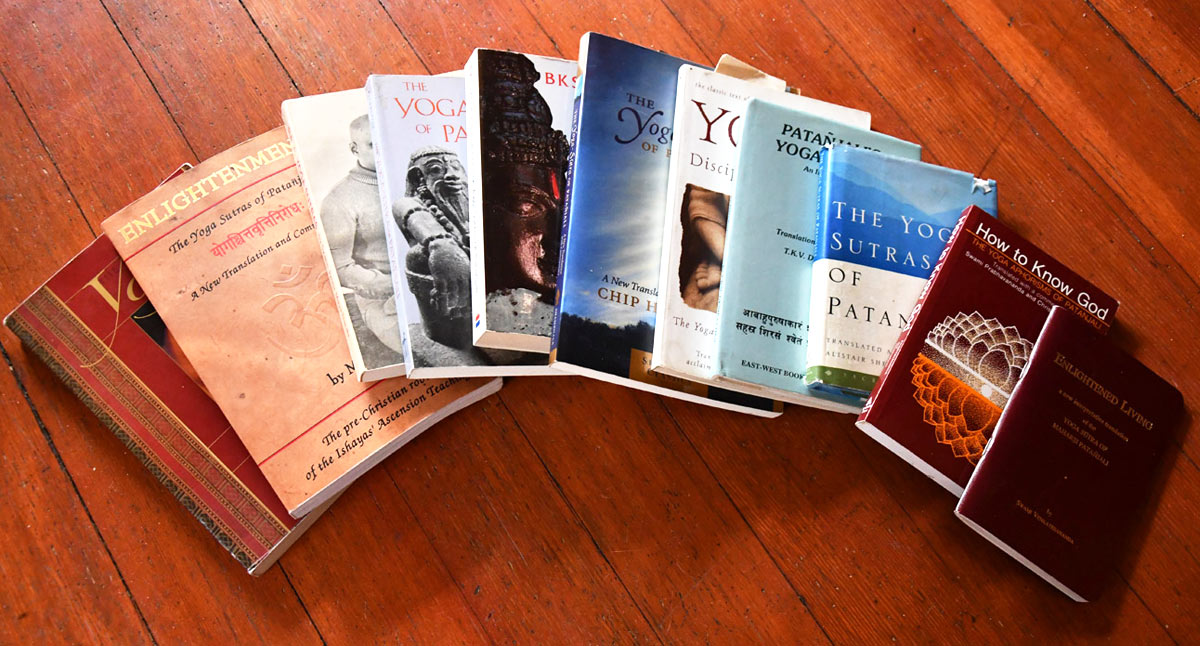
What is yoga? In another article, I attempted to summarize the different aspects of yoga. But I stated the caveat that yoga is not so easy to define. As a 5,000-year-old practice, there are a whole lot of opinions about what yoga is, which tells me that defining yoga is both personal and universal. That is what makes it such a dynamic practice. Many ancient texts attempt to define yoga. In the West, the best known of these include: the Upanishads, The Bhagavad Gita and the Yoga Sutras of Patanjali. Most Western yoga practitioners look to the Yoga Sutras to answer the what is yoga question.
What Are the Yoga Sutras?
The Yoga Sutras are a compilation of ideas about yoga that had formed over centuries. They were likely compiled somewhere between 500 BCE and 400 CE. No one knows anything about the purported author, Patanjali, except that he is often called a sage.
The word sutra means “thread.” Each of the 196 sutras—which are short aphorisms—is a thread in the larger tapestry of yoga. The text includes four parts. I’ll use Alistair Shearer’s translation of the sutra sections here, simply because it was the core text of my sutra study:
- The Settled Mind: An overview of what yoga is
- Treading the Path: The “how-to” part of the text
- Expansion: A description of the powers of a concentrated mind
- Enlightenment: Qualities of awakening
How Do the Yoga Sutras Define Yoga?
Sutra 1.2 (the second aphorism in the text) offers the definition of yoga. All the rest of the sutras flesh out this definition. Here are a few translations:
- Yoga (Union) is consciousness with its movements still. ~ Maharishi Sadashiva Ishaya
- Yoga is the settling of the mind into silence. ~ Alistair Shearer
- Yoga is the ability to direct the mind exclusively towards an object and sustain that direction without any distractions. ~ T.K.V. Desikachar
- Yoga is the cessation of the turnings of thought. ~ Barbara Stoler Miller
- Yoga is the ability to direct focus and mental activity. ~ Bernard Bouanchaud
These are just five of the dozen sutra translations I used when my study partner and I spent seven years exploring the sutras. (This is to say that this short article only barely points to the sutras’ definition of yoga!)
As you can see, there are lots of different interpretations. This is because the sutras were written without any sort of religious coloration. Because of this, each translation reflects the translator’s interpretation. That’s why it’s important to study more than just one translation. In my study, I also read translations by Georg Feuerstein, B.K.S. Iyengar and Chip Hartranft, to name a few.
The Settling of the Mind
My favorite overall translation is Alistair Shearer’s, including and especially his translation of sutra 1.2. While Shearer’s translation of the sutras is not as literal as some, I feel that it expresses the essence of the sutras.
“Yoga is the settling of the mind into silence” speaks to a process of gradual awakening. The word “settling” is dynamic rather than static. I see the path of yoga as an ongoing process, always changing and evolving, and settling into what is true. It’s not a static goal that you someday reach and then everything stops. It’s a gradual, but dynamic, process.
What is the silence this sutra points to? It is a silence that is not dependent on a lack of input from our senses. It is a vast, limitless awareness that is undisturbed by seeing, hearing, tasting, smelling, feeling and thinking. A common metaphor for the silence of yoga is the sky. While all kinds of weather events—wind, rain, snow, tropical storms, tornadoes, etc.—may occur within the context of the sky, the sky never loses its integrity, its sky-like nature.
Studying the Sutras
I encourage you to delve into the sutras. My study partner and I each used about a dozen translations. Alistair Shearer’s translation was our baseline, and we used the others, along with the commentaries, to help us flesh out our understanding. The sutras are divided into small segments of three to five aphorisms. We spent a month studying one of these sections on our own, and then met to discuss what we’d discovered. It took us about seven years, and by the end of it, we agreed that we could easily start over again!

Thank you for this ! It’s incredibly generous of you to explain to a beginner like myself the deeper meanings of a “ practice” . I’m 60 and only recently began yoga seriously , I have struggled to pin down what an “ asana “ etc is . It’s like learning Latin .
This was the best and most thorough guide to how to approach a study – it’s exactly what I’ve been trying to find ( I have 4 books & not one has given me understanding like I got in this beginning article .
I appreciate you having this on your website .
Merry Christmas
Thanks! I love discussing the sutras and the deeper meaning of practice. I’m glad the article was helpful. I’d highly recommend finding a study buddy who’s also interesting in diving into the sutras. I feel like meeting once a month to discuss three to five sutras allowed us to deepen our understanding and kept us consistent. Good luck!